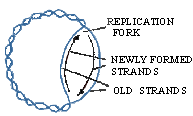|
PinkMonkey Online Study Guide-Biology
8.4 Replication of Prokaryotic Chromosome

Figure 8.7 Replicating circular DNA (q replication)
The DNA of the prokaryotic chromosome replicates as a
circular structure. It is a semiconservative as in the linear DNA
of the eukaryotes. Replication begins a fixed point called the origin.
In most prokaryotes, the DNA has only one ‘origin’ point. The uncoiling
of the two strands of the circular molecule begins at the point
of origin and progresses in opposite directions (bidirectional).
This is helped by the enzyme called DNA gyrase.
Simultaneously with the uncoiling of the original strands, a new complementary strand is being constructed on each strand. As a result, the circular DNA appears as the Greek letter q (theta) during replication (Figure 8.7). Hence this mode of replication is called q replication. Each newly forming strand also goes on helically coiling around its circular template strand (original strand). As a consequence, by the time the replication process is over, two complete double-stranded circular DNA molecules are formed. These are exact copies of the original molecule. Moreover each daughter molecule has one original (parental) and the other newly formed circular strands.
|